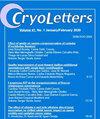Cryopreservation of seeds of Neonotonia wightii Wight and Arn: a strategy for conservation, dormancy breaking and preservation of nutritional status.
IF 1
4区 生物学
Q3 BIOLOGY
引用次数: 0
Abstract
BACKGROUND N. wightii (Leguminosae) is valued as a cover crop and as a potential source of protein in food insecure countries. However, plantlet establishment is limited by physical dormancy. Our previous work has shown that exposure of N. wightii seeds to cryogenic temperatures is able to overcome physical dormancy. OBJECTIVE The current study is an extension of that work where the field performance and nutritional composition of plants regenerated from N. wightii seeds was investigated. RESULTS It was evident that plants regenerated from cryopreserved seeds displayed faster growth rates than those from control seeds. In addition, cryopreservation did not alter the nutritional profile of plants produced from cryo-stored seeds. CONCLUSION Collectively, the results indicate that cryopreservation serves as a suitable strategy for the preservation of seeds of N. wightii with the added benefit of also serving as a dormancy breaking mechanism upon retrieval from cryogenic temperatures. Doi.org/10.54680/fr23510110712.对 Neonotonia wightii Wight 和 Arn 的种子进行低温保存:一种保存、打破休眠和保持营养状态的策略。
背景介绍 N.wightii(豆科植物)是一种重要的覆盖作物,也是粮食不安全国家潜在的蛋白质来源。然而,小植株的建立受到物理休眠的限制。我们之前的研究表明,将 N. wightii 种子暴露在低温下能够克服物理休眠。 目前的研究是这项工作的延伸,研究了由 N. wightii 种子再生的植株的田间表现和营养成分。 结果 很明显,与对照种子相比,低温保存种子再生的植物生长速度更快。此外,低温保存并没有改变由低温保存的种子培育出的植物的营养成分。 总之,研究结果表明,低温保存是一种合适的保存 N. wightii 种子的策略,其额外的好处是在从低温中取出种子时还能起到打破休眠机制的作用。Doi.org/10.54680/fr23510110712.
本文章由计算机程序翻译,如有差异,请以英文原文为准。
求助全文
约1分钟内获得全文
求助全文
来源期刊

Cryo letters
生物-生理学
CiteScore
1.80
自引率
10.00%
发文量
50
审稿时长
1 months
期刊介绍:
A bimonthly international journal for low temperature sciences, including cryobiology, cryopreservation or vitrification of cells and tissues, chemical and physical aspects of freezing and drying, and studies involving ecology of cold environments, and cold adaptation
The journal publishes original research reports, authoritative reviews, technical developments and commissioned book reviews of studies of the effects produced by low temperatures on a wide variety of scientific and technical processes, or those involving low temperature techniques in the investigation of physical, chemical, biological and ecological problems.
 求助内容:
求助内容: 应助结果提醒方式:
应助结果提醒方式:


